Song Notes and Patterns of the Mediterranean Fin Whale (Balaenoptera physalus) in the Ionian Sea
Abstract
:1. Introduction
2. Materials and Methods
2.1. Data Acquisition
2.2. Detection of Notes and Songs
2.3. Classification of the 20-Hz Notes
2.4. Spectral Features
2.5. INI Type Pair Analysis
2.6. Study of Song Patterns
3. Results
3.1. Song Detection and Classification
3.2. INI Type Pairs
3.3. Characterization of Song Patterns
- Simple doublet “B–A–B”: alternation of B–A and A–B INIs, where the shorter B–A was always the initial interval of a unit. This pattern is characterized by the repetition of two main INI types.
- Short triplet “B–A–AS–B”: the A–A INI is a A–A short interval, and two type A notes are always enclosed between the first and the final type B note.
- Complex short “B–(A–AS)n–B” triplet: the A–A INI was classified as A–A short, and n is a value between three and nine which indicates the number of INI A–AS repetitions.
- Complex long “B–(A–AL)n–B” triplet: the A–A INI is A–A long, and n varies between two and five and indicates the number of INI A–AL repetitions.
4. Discussion
5. Conclusions
Author Contributions
Funding
Institutional Review Board Statement
Informed Consent Statement
Data Availability Statement
Acknowledgments
Conflicts of Interest
References
- Cooke, J.G. Balaenoptera physalus. The IUCN Red List of Threatened Species 2018: E.T2478A50349982. 2018. Available online: https://www.iucnredlist.org/species/2478/50349982 (accessed on 12 January 2023).
- Panigada, S.; Gauffier, P.; Notarbartolo di Sciara, G. Balaenoptera physalus (Mediterranean subpopulation). The IUCN Red List of Threatened Species 2021: E.T16208224A50387979. 2021. Available online: https://www.iucnredlist.org/species/16208224/50387979 (accessed on 10 January 2023).
- Castellote, M.; Clark, C.W.; Lammers, M.O. Fin Whale (Balaenoptera physalus) Population Identity in the Western Mediterranean Sea. Mar. Mammal Sci. 2012, 28, 325–344. [Google Scholar] [CrossRef]
- Sciacca, V.; Caruso, F.; Beranzoli, L.; Chierici, F.; De Domenico, E.; Embriaco, D.; Favali, P.; Giovanetti, G.; Larosa, G.; Marinaro, G.; et al. Annual Acoustic Presence of Fin Whale (Balaenoptera physalus) Offshore Eastern Sicily, Central Mediterranean Sea. PLoS ONE 2015, 10, e0141838. [Google Scholar] [CrossRef]
- Pintore, L.; Sciacca, V.; Viola, S.; Giacoma, C.; Papale, E.; Giorli, G. Fin Whale (Balaenoptera physalus) in the Ligurian Sea: Preliminary Study on Acoustics Demonstrates Their Regular Occurrence in Autumn. J. Mar. Sci. Eng. 2021, 9, 966. [Google Scholar] [CrossRef]
- Best, P.; Marxer, R.; Paris, S.; Glotin, H. Temporal Evolution of the Mediterranean Fin Whale Song. Sci. Rep. 2022, 12, 13565. [Google Scholar] [CrossRef]
- Pereira, A.; Harris, D.; Tyack, P.; Matias, L. Fin Whale Acoustic Presence and Song Characteristics in Seas to the Southwest of Portugal. J. Acoust. Soc. Am. 2020, 147, 2235–2249. [Google Scholar] [CrossRef]
- Watkins, W.A.; Tyack, P.; Moore, K.E.; Bird, J.E. The 20-Hz Signals of Finback Whales (Balaenoptera physalus). J. Acoust. Soc. Am. 1987, 82, 1901–1912. [Google Scholar] [CrossRef]
- Edds-walton, P.L. Acoustic Communication Signals of Mysticete Whales. Bioacoustics 1997, 8, 47–60. [Google Scholar] [CrossRef]
- Clark, C.W.; Borsani, J.F.; Notarbartolo-Di-sciara, G. Vocal activity of fin whales, Balaenoptera physalus, in the Ligurian Sea. Mar. Mammal Sci. 2002, 18, 286–295. [Google Scholar] [CrossRef]
- Weirathmueller, M.J.; Stafford, K.M.; Wilcock, W.S.D.; Hilmo, R.S.; Dziak, R.P.; Tréhu, A.M. Spatial and Temporal Trends in Fin Whale Vocalizations Recorded in the NE Pacific Ocean between 2003–2013. PLoS ONE 2017, 12, e0186127. [Google Scholar] [CrossRef]
- Romagosa, M.; Pérez-Jorge, S.; Cascão, I.; Mouriño, H.; Lehodey, P.; Pereira, A.; Marques, T.A.; Matias, L.; Silva, M.A. Food Talk: 40-Hz Fin Whale Calls Are Associated with Prey Biomass. Proc. R. Soc. B Biol. Sci. 2021, 288, 20211156. [Google Scholar] [CrossRef]
- Furumaki, S.; Tsujii, K.; Mitani, Y. Fin Whale (Balaenoptera physalus) Song Pattern in the Southern Chukchi Sea. Polar Biol. 2021, 44, 1021–1027. [Google Scholar] [CrossRef]
- Constaratas, A.N.; McDonald, M.A.; Goetz, K.T.; Giorli, G. Fin Whale Acoustic Populations Present in New Zealand Waters: Description of Song Types, Occurrence and Seasonality Using Passive Acoustic Monitoring. PLoS ONE 2021, 16, e0253737. [Google Scholar] [CrossRef]
- Wood, M.; Širović, A. Characterization of Fin Whale Song off the Western Antarctic Peninsula. PLoS ONE 2022, 17, 11–15. [Google Scholar] [CrossRef]
- Širović, A.; Hildebrand, J.A.; Wiggins, S.M.; Thiele, D. Blue and Fin Whale Acoustic Presence around Antarctica during 2003 and 2004. Mar. Mammal Sci. 2009, 25, 125–136. [Google Scholar] [CrossRef]
- Simon, M.; Stafford, K.M.; Beedholm, K.; Lee, C.M.; Madsen, P.T. Singing Behavior of Fin Whales in the Davis Strait with Implications for Mating, Migration and Foraging. J. Acoust. Soc. Am. 2010, 128, 3200–3210. [Google Scholar] [CrossRef]
- Morano, J.L.; Salisbury, D.P.; Rice, A.N.; Conklin, K.L.; Falk, K.L.; Clark, C.W. Seasonal and Geographical Patterns of Fin Whale Song in the Western North Atlantic Ocean. J. Acoust. Soc. Am. 2012, 132, 1207–1212. [Google Scholar] [CrossRef]
- Oleson, E.M.; Širović, A.; Bayless, A.R.; Hildebrand, J.A. Synchronous Seasonal Change in Fin Whale Song in the North Pacific. PLoS ONE 2014, 9, e115678. [Google Scholar] [CrossRef]
- Stafford, K.M.; Mellinger, D.K.; Moore, S.E.; Fox, C.G. Seasonal Variability and Detection Range Modeling of Baleen Whale Calls in the Gulf of Alaska, 1999–2002. J. Acoust. Soc. Am. 2007, 122, 3378–3390. [Google Scholar] [CrossRef]
- Kershenbaum, A.; Blumstein, D.T.; Roch, M.A.; Akçay, Ç.; Backus, G.; Bee, M.A.; Bohn, K.; Cao, Y.; Carter, G.; Cäsar, C.; et al. Acoustic Sequences in Non-Human Animals: A Tutorial Review and Prospectus. Biol. Rev. 2016, 91, 13–52. [Google Scholar] [CrossRef]
- Croll, D.A.; Clark, C.W.; Acevedo, A.; Tershy, B.; Gedamke, J.; Urban, J.; Suki, B. Only Male Fin Whales Sing Loud Songs. Nature 2002, 417, 809–811. [Google Scholar] [CrossRef]
- Mcdonald, M.A.; Hildebrand, J.A.; Webb, S.C. Blue and Fin Whales Observed on a Seafloor Array Pacific. J. Acoust. Soc. Am. 1995, 98, 712–721. [Google Scholar] [CrossRef]
- Širović, A.; Williams, L.N.; Kerosky, S.M.; Wiggins, S.M.; Hildebrand, J.A. Temporal Separation of Two Fin Whale Call Types across the Eastern North Pacific. Mar. Biol. 2013, 160, 47–57. [Google Scholar] [CrossRef] [PubMed]
- Soule, D.C.; Wilcock, W.S.D. Fin Whale Tracks Recorded by a Seismic Network on the Juan de Fuca Ridge, Northeast Pacific Ocean. J. Acoust. Soc. Am. 2013, 133, 1751–1761. [Google Scholar] [CrossRef] [PubMed]
- Sciacca, V.; Morello, G.; Filiciotto, F. Measuring Fin Whale Songs in a Noisy Environment. In The Effects of Noise on Aquatic Life; Popper, A.N., Sisneros, J., Hawkins, A.D., Thomsen, F., Eds.; Springer: Cham, Switzerland, 2023. [Google Scholar] [CrossRef]
- Watkins, W.A. Activities and Underwater Sounds of Fin Whales (Balaenoptera physalus). Sci. Rep. Whales Res. Inst. Tokyo 1981, 33, 83–117. [Google Scholar]
- Thompson, P.O.; Findley, L.T.; Vidal, O. 20-Hz Pulses and Other Vocalizations of Fin Whales, Balaenoptera physalus, in the Gulf of California, Mexico. J. Acoust. Soc. Am. 1992, 92, 3051–3057. [Google Scholar] [CrossRef]
- Širović, A.; Oleson, E.M.; Buccowich, J.; Rice, A.; Bayless, A.R. Fin Whale Song Variability in Southern California and the Gulf of California. Sci. Rep. 2017, 7, 10126. [Google Scholar] [CrossRef]
- Helble, T.A.; Guazzo, R.A.; Alongi, G.C.; Martin, C.R.; Martin, S.W.; Henderson, E.E. Fin Whale Song Patterns Shift Over Time in the Central North Pacific. Front. Mar. Sci. 2020, 7, 587110. [Google Scholar] [CrossRef]
- Favali, P.; Chierici, F.; Marinaro, G.; Giovanetti, G.; Azzarone, A.; Beranzoli, L.; De Santis, A.; Embriaco, D.; Monna, S.; Lo Bue, N.; et al. NEMO-SN1 Abyssal Cabled Observatory in the Western Ionian Sea. IEEE J. Ocean. Eng. 2013, 38, 358–374. [Google Scholar] [CrossRef]
- EMSO ERIC Website. Available online: https://emso.eu (accessed on 19 October 2023).
- Embriaco, D.; Marinaro, G.; Giovanetti, G. Hydrophone Dataset (SMID DT-405D(V)1 @ 2 kHz) from INGV/NEMO-SN1 Seafloor Platform during SMO Project in Western Ionian Sea Site (East Sicily), Part of EMSO Network [Data Set]. Istituto Nazionale di Geofisica e Vulcanologia (INGV). 2012. Available online: https://doi.org/10.13127/MD/600DBC39-8769-4FA3-8154-7DD71EFA659E (accessed on 18 October 2023).
- Crane, N.L.; Lashkari, K. Sound Production of Gray Whales, Eschrichtius Robustus, along Their Migration Route: A New Approach to Signal Analysis. J. Acoust. Soc. Am. 1996, 100, 1878–1886. [Google Scholar] [CrossRef]
- Samaran, F.; Adam, O.; Guinet, C. Detection Range Modeling of Blue Whale Calls in Southwestern Indian Ocean. Appl. Acoust. 2010, 71, 1099–1106. [Google Scholar] [CrossRef]
- Geijer, C.K.A.; Notarbartolo di Sciara, G.; Panigada, S. Mysticete Migration Revisited: Are Mediterranean Fin Whales an Anomaly? Mamm. Rev. 2016, 46, 284–296. [Google Scholar] [CrossRef]
- Monaco, C.; Ibáñez, J.M.; Carrión, F.; Tringali, L.M. Cetacean behavioral responses to noise exposure generated by seismic surveys: How to mitigate better? Ann. Geophys. 2016, 59, S0436. [Google Scholar]
- Viola, S.; Grammauta, R.; Sciacca, V.; Bellia, G.; Beranzoli, L.; Buscaino, G.; Caruso, F.; Chierici, F.; Cuttone, G.; D’Amico, A.; et al. Continuous Monitoring of Noise Levels in the Gulf of Catania (Ionian Sea). Study of Correlation with Ship Traffic. Mar. Pollut. Bull. 2017, 121, 97–103. [Google Scholar] [CrossRef] [PubMed]
- Weirathmueller, M.J.; Wilcock, W.S.D.; Soule, D.C. Source Levels of Fin Whale 20 Hz Pulses Measured in the Northeast Pacific Ocean. J. Acoust. Soc. Am. 2013, 133, 741–749. [Google Scholar] [CrossRef] [PubMed]
- Garcia, H.A.; Zhu, C.; Schinault, M.E.; Kaplan, A.I.; Handegard, N.O.; Godø, O.R.; Ahonen, H.; Makris, N.C.; Wang, D.; Huang, W.; et al. Temporal–Spatial, Spectral, and Source Level Distributions of Fin Whale Vocalizations in the Norwegian Sea Observed with a Coherent Hydrophone Array. ICES J. Mar. Sci. 2019, 76, 268–283. [Google Scholar] [CrossRef]
- Notarbartolo-Di-Sciara, G.; Zanardelli, M.; Jahoda, M.; Panigada, S.; Airoldi, S. The Fin Whale Balaenoptera physalus (L. 1758) in the Mediterranean Sea. Mamm. Rev. 2003, 33, 105–150. [Google Scholar] [CrossRef]
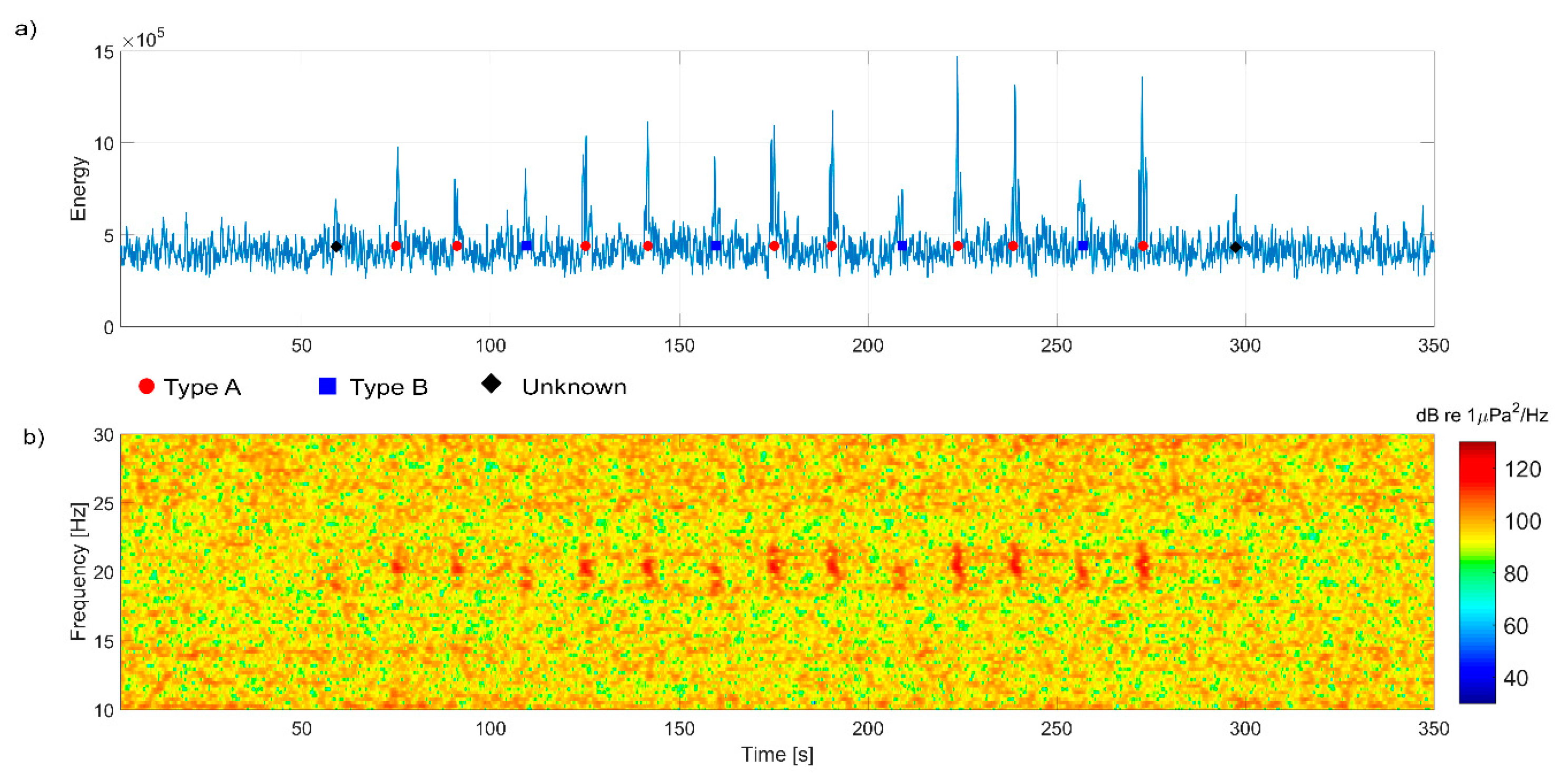
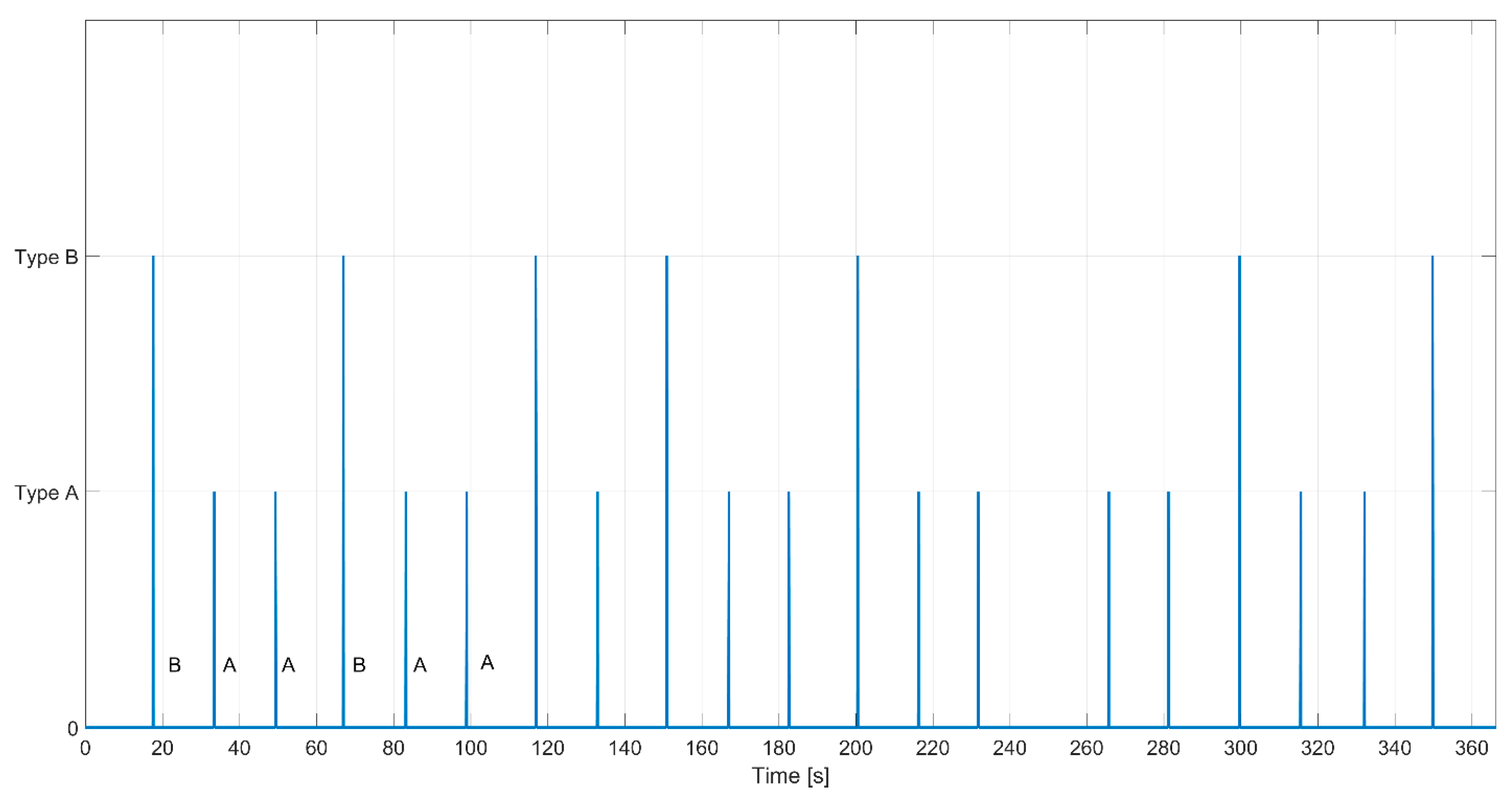
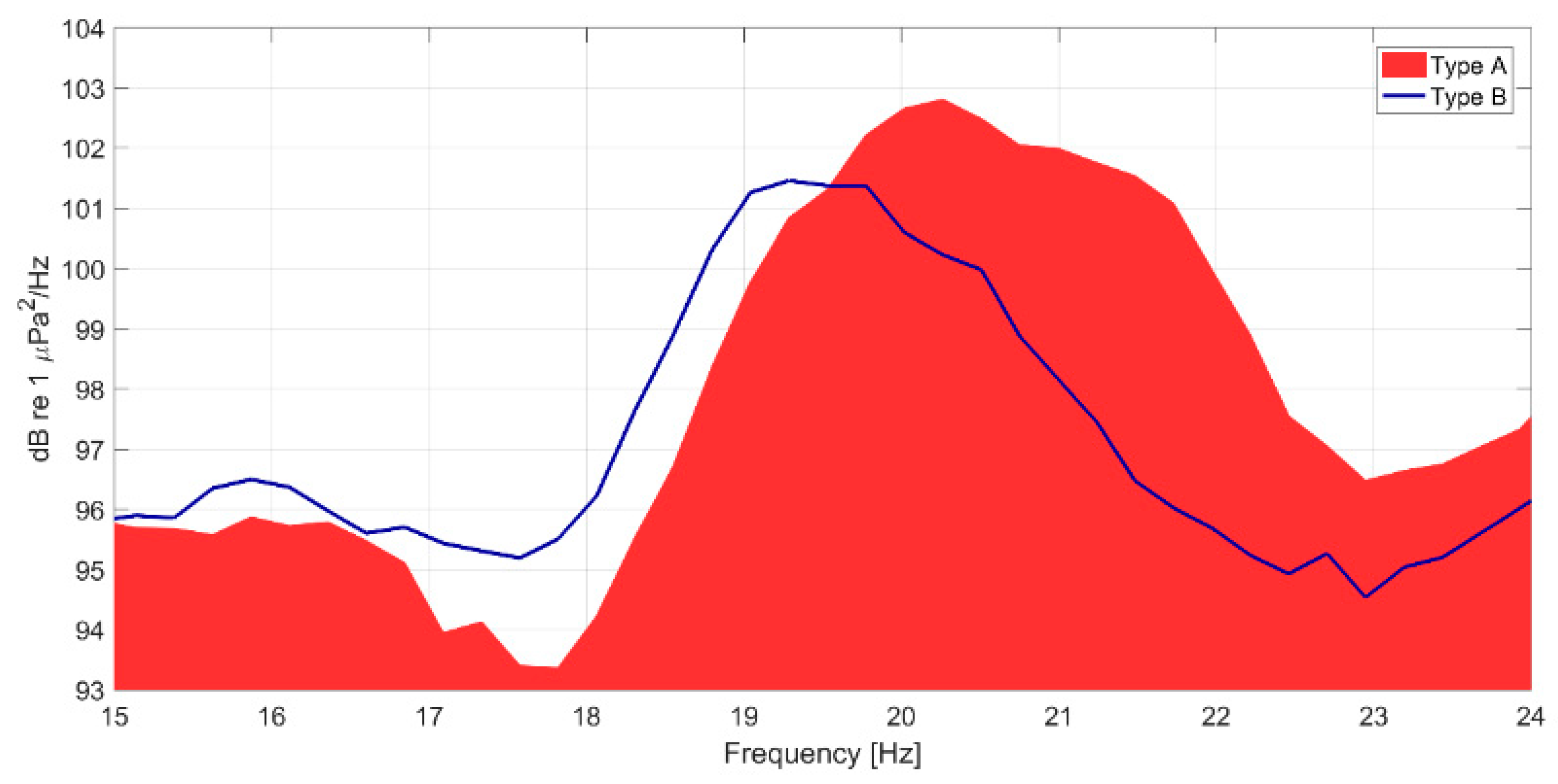

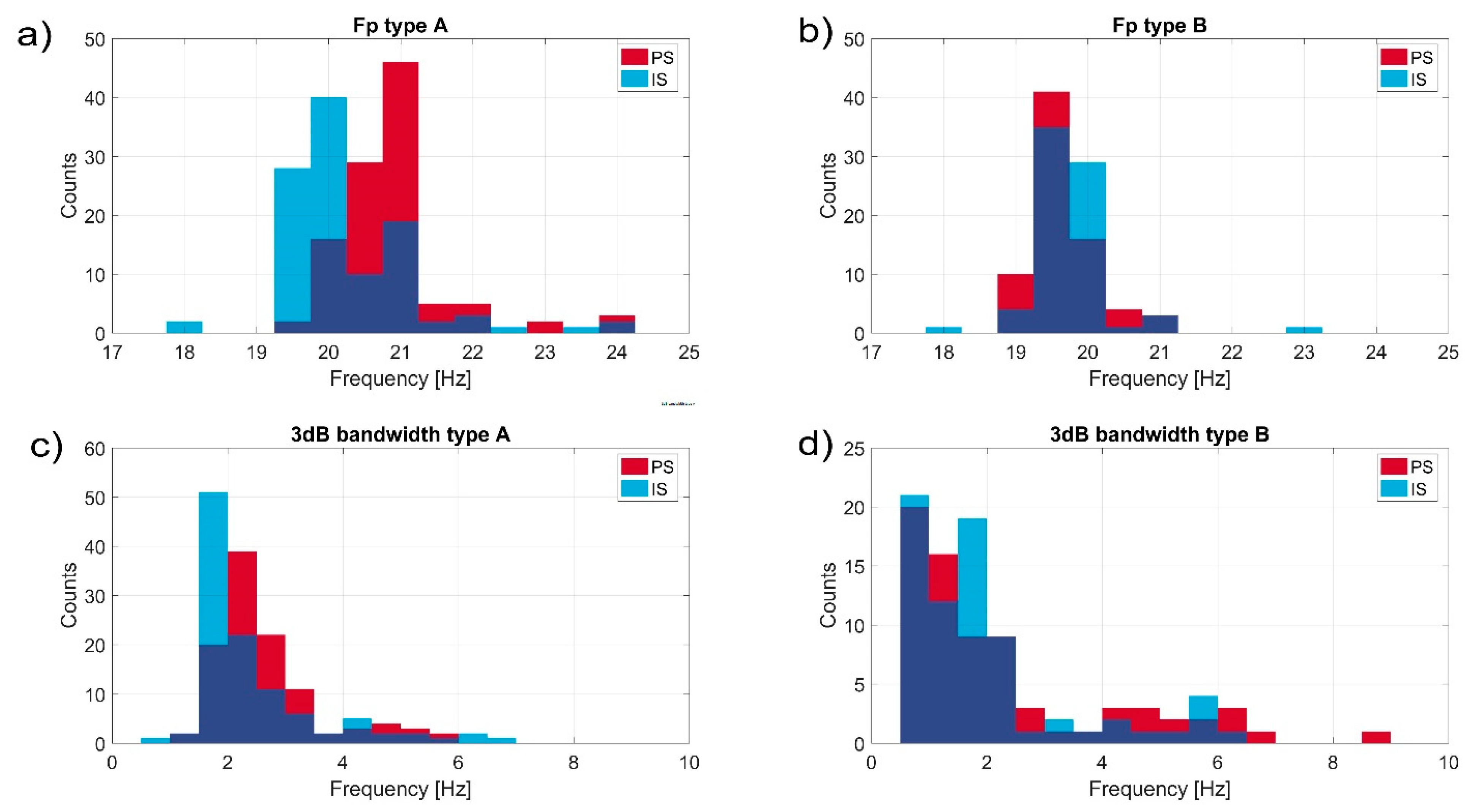
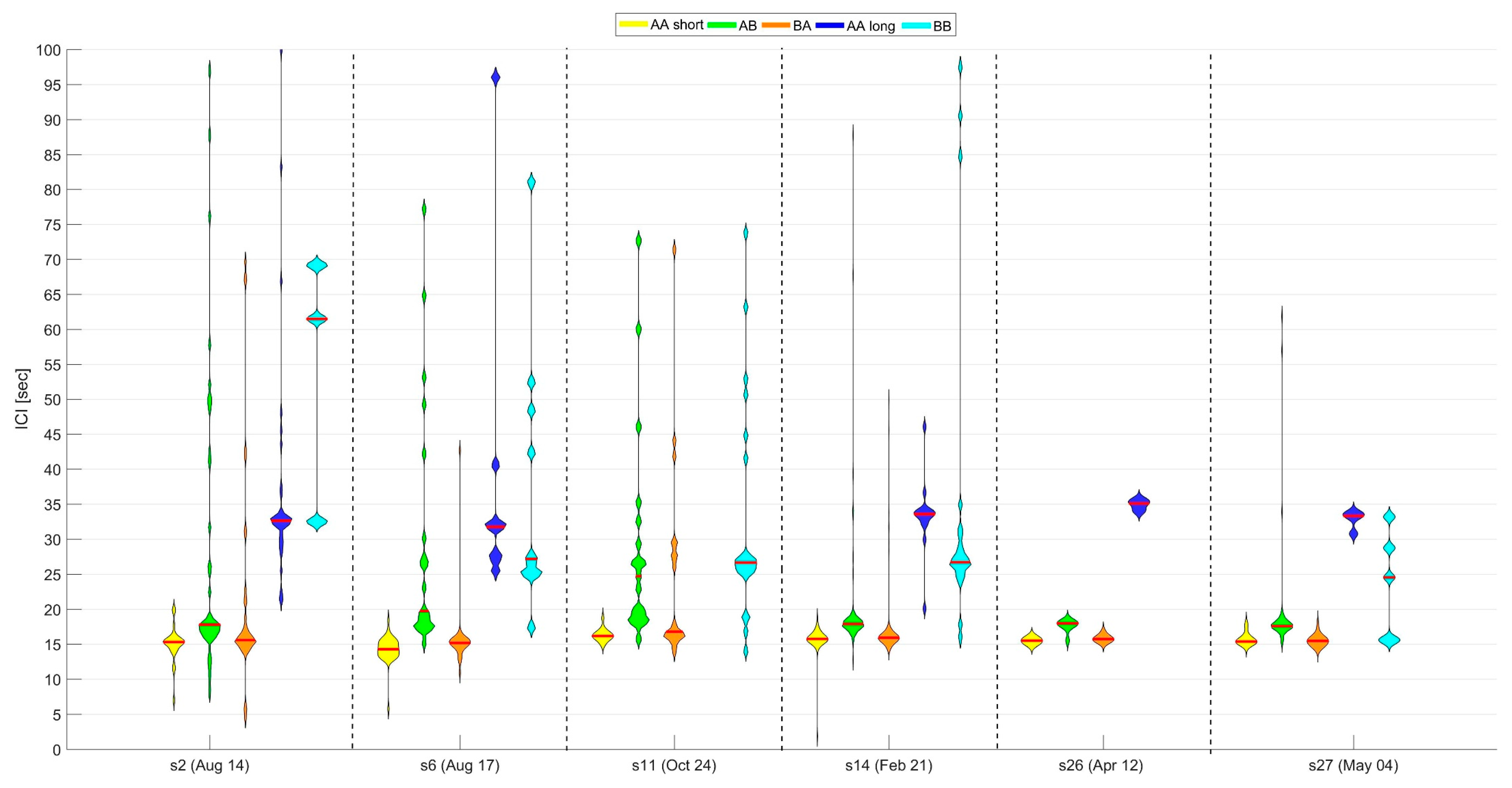
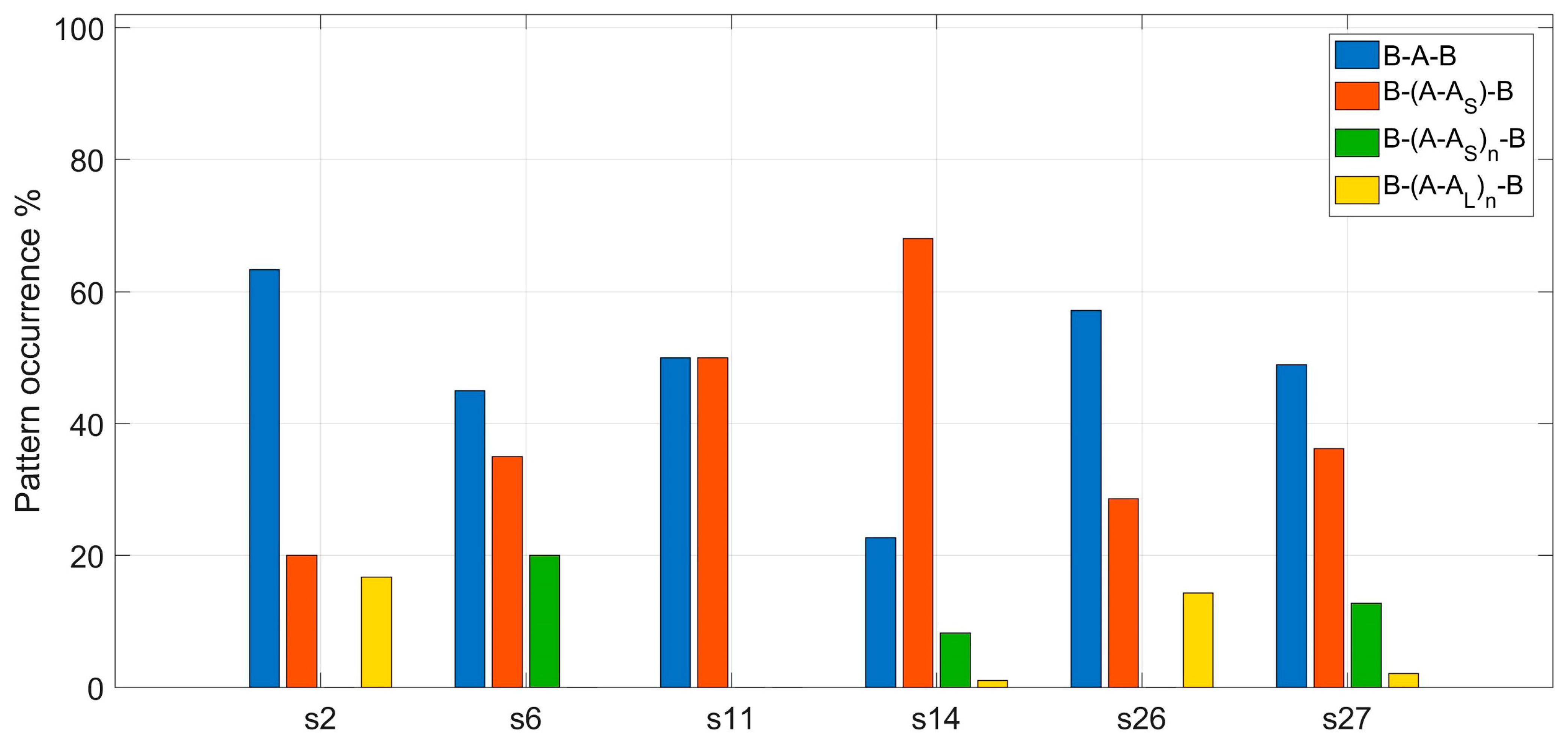
| Song ID | Date | Dur [min] | Start | Notes | Type A | Type B | Unknown |
|---|---|---|---|---|---|---|---|
| S1 | July-02 | 10 | 12:30 | 7 | 4 | 3 | 0 |
| S2 | August-14_1 | 240 | 13:00 | 227 | 117 | 47 | 63 |
| S3 | August-14_2 | 50 | 21:10 | 42 | 29 | 13 | 0 |
| S4 | August-15 | 30 | 02:30 | 10 | 3 | 6 | 1 |
| S5 | August-16 | 20 | 22:40 | 15 | 8 | 7 | 0 |
| S6 | August-17 | 220 | 02:40 | 155 | 97 | 55 | 3 |
| S7 | August-29 | 40 | 11:20 | 31 | 10 | 4 | 17 |
| S8 | August-30 | 70 | 02:50 | 18 | 5 | 4 | 9 |
| S9 | September-24_1 | 220 | 11:30 | 160 | 37 | 38 | 85 |
| S10 | September-24_2 | 120 | 18:20 | 123 | 48 | 19 | 56 |
| S11 | October-24_1 | 80 | 03:50 | 97 | 43 | 52 | 2 |
| S12 | October-24_2 | 20 | 12:10 | 7 | 4 | 3 | 0 |
| S13 | October-28 | 30 | 16:20 | 20 | 2 | 1 | 17 |
| S14 | February-21 | 270 | 01:10 | 390 | 226 | 146 | 18 |
| S15 | February-26_1 | 20 | 10:40 | 13 | 0 | 6 | 7 |
| S16 | February-26_2 | 40 | 16:30 | 40 | 0 | 0 | 40 |
| S17 | February-26_3 | 60 | 22:20 | 43 | 6 | 5 | 32 |
| S18 | March-04_1 | 20 | 01:20 | 16 | 4 | 12 | 0 |
| S19 | March-04_2 | 110 | 04:50 | 99 | 5 | 14 | 80 |
| S20 | March-04_3 | 100 | 10:50 | 106 | 16 | 9 | 81 |
| S21 | March-04_4 | 170 | 15:30 | 104 | 5 | 7 | 92 |
| S22 | March-05 | 20 | 01:50 | 18 | 2 | 0 | 16 |
| S23 | March-09 | 70 | 14:30 | 72 | 0 | 0 | 72 |
| S24 | March-30 | 40 | 15:20 | 23 | 2 | 3 | 18 |
| S25 | April-07 | 20 | 22:10 | 4 | 0 | 4 | 0 |
| S26 | April-12_1 | 80 | 08:20 | 73 | 17 | 13 | 43 |
| S27 | April-12_2 | 210 | 18:10 | 332 | 97 | 63 | 172 |
| S28 | May-04 | 30 | 09:00 | 5 | 0 | 1 | 4 |
| Sum | 2410 | 2250 | 787 | 535 | 928 |
| A–AS | A–AL | A–B | B–A | B–B | |
|---|---|---|---|---|---|
| N | 222 | 65 | 232 | 249 | 63 |
| Mean | 15.40 | 35.94 | 22.79 | 17.92 | 34.30 |
| SE | 0.12 | 1.78 | 0.91 | 0.55 | 2.41 |
| Variance | 2.98 | 205.62 | 192.49 | 75.80 | 367.03 |
| SD | 1.73 | 14.34 | 13.87 | 8.71 | 19.16 |
| Median | 15.51 | 32.80 | 17.90 | 15.75 | 26.86 |
| 25 percentile | 15.08 | 31.77 | 17.43 | 15.26 | 25.10 |
| 75 percentile | 16.04 | 34.00 | 18.80 | 16.36 | 34.45 |
| IqR | 0.96 | 2.23 | 1.38 | 1.10 | 9.34 |
| A–AS | A–AL | A–B | B–A | B–B | |
|---|---|---|---|---|---|
| N | 8 | 44 | 40 | 23 | 26 |
| Mean | 14.22 | 35.01 | 37.19 | 26.83 | 35.58 |
| SE | 1.14 | 1.82 | 4.94 | 2.61 | 2.87 |
| Variance | 10.40 | 146.30 | 561.38 | 177.07 | 329.78 |
| SD | 3.22 | 12.10 | 23.69 | 13.31 | 18.16 |
| Median | 14.01 | 29.78 | 27.72 | 26.71 | 27.99 |
| 25 percentile | 11.83 | 27.20 | 26.40 | 15.63 | 26.76 |
| 75 percentile | 16.22 | 35.69 | 50.00 | 29.02 | 34.24 |
| IqR | 4.39 | 8.49 | 23.60 | 13.39 | 7.47 |
| PS | IS | |||||||||
|---|---|---|---|---|---|---|---|---|---|---|
| S2 | S6 | S11 | S14 | S26 | S27 | S3 | S9 | S10 | S19 | |
| A–AL | 24.49 | 40.00 | 22.95 | 29.76 | 21.05 | 25.55 | 22.58 | 0.00 | 0.00 | 0.00 |
| A–AS | 23.47 | 5.45 | 0.00 | 2.98 | 0.00 | 2.19 | 12.90 | 16.67 | 45.95 | 0.00 |
| A–B | 21.43 | 10.91 | 18.03 | 27.98 | 42.11 | 32.85 | 25.81 | 23.33 | 10.81 | 26.67 |
| B–A | 26.53 | 29.09 | 16.39 | 30.06 | 36.84 | 35.04 | 22.58 | 23.33 | 13.51 | 20.00 |
| B–B | 4.08 | 14.55 | 42.62 | 9.23 | 0.00 | 4.38 | 16.13 | 36.67 | 29.73 | 53.33 |
| F Peak | 3 dB Bandwidth | |||||||
|---|---|---|---|---|---|---|---|---|
| Type A | Type B | Type A | Type B | |||||
| PS | IS | PS | IS | PS | IS | PS | IS | |
| N | 108 | 108 | 74 | 74 | 108 | 108 | 74 | 74 |
| Mean | 20.82 | 20.21 | 19.59 | 19.65 | 2.72 | 2.52 | 2.31 | 2.04 |
| SE | 0.08 | 0.09 | 0.05 | 0.07 | 0.09 | 0.11 | 0.21 | 0.16 |
| Median | 20.75 | 19.78 | 19.53 | 19.53 | 2.44 | 2.08 | 1.71 | 1.71 |
| Min | 19.29 | 18.07 | 19.04 | 18.07 | 1.46 | 0.98 | 0.73 | 0.73 |
| Max | 23.93 | 23.93 | 20.75 | 22.95 | 5.86 | 6.59 | 8.79 | 6.10 |
Disclaimer/Publisher’s Note: The statements, opinions and data contained in all publications are solely those of the individual author(s) and contributor(s) and not of MDPI and/or the editor(s). MDPI and/or the editor(s) disclaim responsibility for any injury to people or property resulting from any ideas, methods, instructions or products referred to in the content. |
© 2023 by the authors. Licensee MDPI, Basel, Switzerland. This article is an open access article distributed under the terms and conditions of the Creative Commons Attribution (CC BY) license (https://creativecommons.org/licenses/by/4.0/).
Share and Cite
Sciacca, V.; Morello, G.; Beranzoli, L.; Embriaco, D.; Filiciotto, F.; Marinaro, G.; Riccobene, G.M.; Simeone, F.; Viola, S. Song Notes and Patterns of the Mediterranean Fin Whale (Balaenoptera physalus) in the Ionian Sea. J. Mar. Sci. Eng. 2023, 11, 2057. https://doi.org/10.3390/jmse11112057
Sciacca V, Morello G, Beranzoli L, Embriaco D, Filiciotto F, Marinaro G, Riccobene GM, Simeone F, Viola S. Song Notes and Patterns of the Mediterranean Fin Whale (Balaenoptera physalus) in the Ionian Sea. Journal of Marine Science and Engineering. 2023; 11(11):2057. https://doi.org/10.3390/jmse11112057
Chicago/Turabian StyleSciacca, Virginia, Giuseppe Morello, Laura Beranzoli, Davide Embriaco, Francesco Filiciotto, Giuditta Marinaro, Giorgio Maria Riccobene, Francesco Simeone, and Salvatore Viola. 2023. "Song Notes and Patterns of the Mediterranean Fin Whale (Balaenoptera physalus) in the Ionian Sea" Journal of Marine Science and Engineering 11, no. 11: 2057. https://doi.org/10.3390/jmse11112057
APA StyleSciacca, V., Morello, G., Beranzoli, L., Embriaco, D., Filiciotto, F., Marinaro, G., Riccobene, G. M., Simeone, F., & Viola, S. (2023). Song Notes and Patterns of the Mediterranean Fin Whale (Balaenoptera physalus) in the Ionian Sea. Journal of Marine Science and Engineering, 11(11), 2057. https://doi.org/10.3390/jmse11112057






